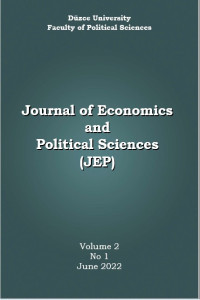Abstract
Çin'in 1970'lerin sonlarından itibaren başlattığı dışa açılma ve ekonomik reformlarına
bakıldığında bu reformların en başında kamu işletmeleri reformu geldiği görülmektedir.
Ekonomik yapısında yoğun devlet kontrolüne sahip Çin Halk Cumhuriyeti'nde KİT'lere
yönelik geçmişteki reformlar, Çin'in son yıllardaki hızlı ekonomik yükselişi için bir
katalizör olsa da, KİT'ler artık verimlilik performansları ve ekonomik büyümeye katkıları
açısından devlet dışı sektörün gerisinde kalmışlardır. Ancak, özellikle siyasi sistemdeki
ayrıcalıklı konumları neticesinde ülkenin mali kaynaklarının orantısız bir şekilde
dağıtılması KİT'leri ekonominin birçok kilit alanına hakim olmaya devam ettirmekte ve
bugün Çin KİT'leri dünyanın en büyük firmaları arasında yer almaktadırlar. Bu
makalede, Çin'in KİT'lere yönelik reform hamleleri ve sonuçları yıllara göre genel
hatlarıyla dört aşamada incelenecektir. İncelemede, Çin'in reform programının
niyetlerini, başarılarını ve eksikliklerini tanımlayan literatürden yararlanılarak son 40
yılda Çin'in devlet sektöründeki reformunun hangi aşamalardan geçtiği ve ekonomik
etkilerinin ne olduğu ana hatlarıyla sunulacaktır. KİT'lerin yıllar içindeki değişimi
özellikle küçüklerin birleşerek bugün dünya çapında şirketlere dönüşmeleri ve rekabetçi
yapıları ortaya koymuştur ki günümüze kadar süre gelen KİT reformunun bugün Çin'in
dünyanın en büyük ikinci ekonomisi olmasında payı yüksektir.
Keywords
References
- Chen, D. (2018). "Why Is China's SOEs Reform Always Disappointing-A New Political Economic Explanation". J. Comp. L., 13, 120.
- Congressional Research Service (2019). China’s Economic Rise: History, Trends, Challenges, and Implications for the United States.
- Çin Komünist Partisi (ÇKP) 18. Merkez Komitesi Üçüncü Genel Kurul Toplantısı Bildirisi; 9 - 12 Kasım 2013.
- Dobson, W. (2014). "China's State-Owned Enterprises and Canada's FDI Policy"; SPP Research Paper, (7-10)
- Dollar, D. (1990). "Economic Reform and Allocative Efficiency in China’s State-owned Industry", Economic Development and Cultural Change, vol. 34, pp.89–105
- Fortune, Global 500, https://fortune.com/fortune500/2022 (Erişim Tarihi: 08. 04.2022).
- Garnaut, R., Song, L., & Yao, Y. (2006). "Impact and Significance of State-owned Enterprise Restructuring in China". The China Journal, (55), 35-63.
- Glawea, L. & Wagner, H. "A Stylized Model of China’s Growth Since 1978" University of Hagen, 2017
- Groves, T., Hong, Y., McMillan, J. & Naughton, B. (1994). "Autonomy Andincentives in Chinese State Enterprises", Quarterly Journal of Economics, vol.109, pp. 183–209.
- Guoqiang, T. (2000). "China’s Reforms: Past, Present and Future", American Review of China Studies, 1, 1-8.
- Hsieh, C. T., & Song, Z. M. (2015). Grasp the large, let go of the small: The transformation of the state sector in China (No. w21006). National Bureau of Economic Research.
- Jefferson, G. (2016). "State-Owned Enterprise in China: Reform, Performance, and Prospects"; Working Papers 109, Economics Department, Brandeis University.
- Jefferson, Garry H. & Xu, W. (1991). "The Impact of Reform Socialist Enterprises in Transition: Structure, Conduct, And Performance in Chinese Industry"; Journal of Comparative Economics, vol. 15, pp. 45–64.
- Kissenger, H. (2015). "Dünden Bugüne Yeni Çin". Kaknüs Yayınları.
- Kobayashi, S., Baobo, J., & Sano, J. (1999). "The “Three Reforms” in China: Progress and Outlook". RIM Pacific Business and Industries, 45, 2-41.
- LAM W. R. & Schipke A. (2017). State-Owned Enterprise Reform. International Monetary Institute (IMI) Working Paper No: 1906.
- Lee, J. (2009). "State owned enterprises in China: Reviewing the evidence". OECD Occasional Paper, 6-7.
- Lee, K. (1990). "The Chinese Model of the Socialist Enterprise: an Assessment Of its Organization and Performance", Journal of Comparative Economics, vol. 14, pp. 384–400
- Mai, L. (2005). Evaluation of the Effectiveness of the World Bank's Analytical and Advisory Services to China since 1990 (No. 82116, 1-21). The World Bank.
- Mattlin, M. (2007). "The Chinese Government's New Approach to Ownership and Financial Control of Strategic State-Owned Enterprises"; BOFITDiscussion Paper No. 10/2007.
- McNally, C. A. (2002). China’s State-Owned Enterprises: Thriving or Crumbling?. Analysis from the East-West Center, No. 59.
- Mo, Pak. Hung, & Sungko. (1998). "Contract Responsibility Systems and Productive Efficiency: A Case Study on StateOwned Enterprises in China". Bulletin of Economic Research, 50(4), 323-341.
- National Bureau of Statistics of China, (2022) http://www.stats.gov.cn/english/, (Erişim Tarihi: 08.04.2022).
- Naughton, B. (2018). "State Enterprise Reform Today". (Ch. 20). China’s 40 Years of Reform and Development.
- Qi, H., & Kotz, D. M. (2020). "The Impact of State-owned Enterprises on China’s Economic Growth." Review of Radical Political Economics, 52(1), 96-114.
- Saraçoğlu, M., & Duran, C. (2008). "Çin Ekonomisindeki Reformlar ve Çin’in Dünya Ticaret Örgütüne Üyeliği Üzerine Bir Değerlendirme" Kamu İş Dergisi, 10(1), 93-112.
- Song, L. (2018). "State-owned Enterprise Reform in China: Past, Present and Prospects." (Ch.19). "China’s 40 Years of Reform and Development, 345-373.
- Xiao, C. (2020). The Evolution of China’s Township and Village Enterprises. The Center for International Knowledge on Development (CIKD).
- Zhang C. (2019) "How Much Do State-Owned Enterprises Contribute to China’s GDP and Employment?". World Bank.
- Zuo, C. (2009). "Township and Village Enterprises in China’s Sustainable Development in China". Area Studies–China: Regional Sustainable Development Review.
Details
| Primary Language | Turkish |
|---|---|
| Subjects | Economics, International Relations |
| Journal Section | Research Article |
| Authors | |
| Publication Date | July 8, 2022 |
| Submission Date | March 22, 2022 |
| Published in Issue | Year 2022 Volume: 2 Issue: 1 |

